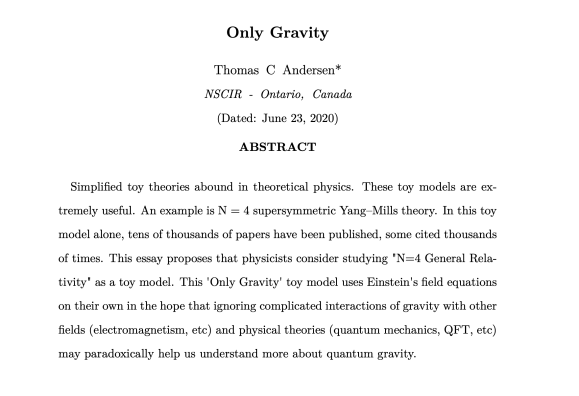This is obviously straight from the hip, although I have been thinking about it for a while. ΛCDM (Lambda cold dark matter) or Lambda-CDM has a lot of problems, but MOND does too. See for example Hossenfelders latest video
So my admittedly personal view is that matter cannot exist on its own. One hydrogen molecule will start to sleep if it’s not near other atoms. How near? The thought is that dark matter densities can tell us.
Abstract
Matter cannot exist on its own, isolated. It needs a certain density of quantum waves or energy to bathe in. Otherwise the entire mechanism of both electromagnetism, quantum mechanics (and maybe nuclear forces) simply dies, the interactive particles (quarks and electrons) that form matter relax into sleeping versions of themselves, likely with virtually all of the mass intact. When in the presence of normal matter or the density of sleeping matter goes up to maybe something like an extremely diffuse gas cloud, the matter wakes up, and starts to take part in electromagnetic interactions. Indeed, the nuclear forces of this sleepy matter do not have to sleep, as we can’t see sleeping nucleons. Perhaps just the EM interaction drops off. This article explores some predictions and consequences of the Sleepy Matter Model.
Hypothesis:
Dark matter is sleepy matter, and dark energy is the ‘quantum energy’ – the dark energy is released when matter ‘goes to sleep’.
Dark matter is just plain matter, but it has ‘spun down’ due to being lonely. This effect happens at about the maximum density of dark matter ever found, or about the density of the most diffuse clouds of gas ever found (which are about equal).

Dark Matter Problems
There are a number of problems with the ΛCDM model (Lambda cold dark matter).
I will refer to as normal dark matter as Dark Matter.
Wikipedia is a good place to start for most of these problems. One can see the Bullet cluster below, which is both a problem and a victory for Dark Matter. That’s where we sit.
| Dark Matter Problem | Problem | Sleepy Matter solution |
| Satellite galaxies | Models of DM predict lots of Satellite galaxies. More are being found, but they tend to be equatorial to the galaxy, which is another problem. | Sleepy matter interacts with density rise on galactic plane and gets stuck there as the core of a satellite galaxy. Should be able to model this. |
| Baryonic Tully Fisher relation | The mass of a galaxy is correlated to the fourth power of the rotation velocity of the outermost stars. Why would Dark Matter, which ignores regular matter obey this rule? | Sleepy matter wakes up when the density gets high, turning into normal matter. This normal matter interacts, limiting density, etc. There is only so much sleepy matter to fit in. Should be able to model this. |
| Renzo’s rule | “For any feature in the luminosity profile there is a corresponding feature in the rotation curve and vice versa.” | This is simple with sleepy matter. Stars are born when sleepy matter wakes up, condenses. |
| Bullet Cluster | Galactic velocities are too high. | The braking friction power of dark matter is lost as the sleeping matter can’t get near luminous matter to put the brakes on. |
| Core-Cusp | No dark matter found (via gravitational searches) in the cores of galaxies. | The sleepy matter comes in, get woken up, interacts, and thus does not sink into the centre. |
| Why Dark Matter | No reason for it, its just another set of parameters. | Sleepy matter is an experimental prediction of both matter and fields arising from the Einstein’s ether, and thus is predicted. |
Dark matter victories
Any new solution to the dark matter problem would hopefully not touch the success of the dark matter paradigm
| Dark Matter Victory | Explanation | Sleepy matter comment |
| Galaxy Clusters | The virial theorem says galactic clusters have dark matter holding them together. Lots of it. | Not a problem, since this intergalactic sleepy matter behaves just like dark matter. |
| Einstein rings, gravitational lensing | The pretty pictures of Einstein rings, carefully measured, show much more mass around a galaxy than is in it that we can see. | Not a problem, as the sleepy matter is at low densities when the entire halo is taken into account. |
| Early universe 2nd peak and all that. | The explanations of the CMB multipole work well with Dark Matter. | One might think that at early universe times, all the matter was awake, which would not be good for the model, but on the other hand, BBN troubles in the early U combined with a much different interaction scheme for matter and dark energy would change things. A 20 parameter LCDM cosmological model with 1000 PhDs and tens of thousands of papers will fit anything. |
| Bullet Cluster | The dark matter from two colliding galaxies sailed right through each other. The gravitational field shows 1) lots of dark matter and 2) It did not interact like the regular stuff to the collision. | Sleeping matter can run right through each other, as long as the critical density is missed. So one gets both the correct density profile and lots of star formation, etc. |
Sleepy matter predictions
Here are some predictions for sleepy matter. Some of the tests can be done today with ‘only’ a literature search and some graphing tools. Others require labs that likely can’t be built on earth or in the near future.
| Prediction | Details | Test |
| Sleepy matter can’t be detected in current experiments. | The sleeping matter is ~all woken up by the time it gets to a lab on earth. | More negative results looking for WIMPs, Axions, etc etc. So far 30 years of bright people have looked for dark matter, mostly by going deep into the earth. |
| Sleepy matter might be detectable in a new kind of experiment. | Perhaps we can simply watch matter fall apart. | Maybe a (deep space?) lab with a large, cold dark room can make a rarefied gas sleep. Could be detected by lighting up a gas at some emission line as it’s pumped down in pressure. Maybe the matter will start to sleep as the pressure drops. Make a graph of pressure as measured by some direct method, and pressure measured by the emission of the atoms in the gas on excitation pulses at one per hour. |
| Clouds of dark matter have a maximum density. | Maybe ordinary matter gas clouds have a minimum observed density already? | Extensive literature search for gas densities measured around our galaxy, combines with literature search for dark matter densities. Do the distributions overlap? I am thinking they don’t overlap, to within the statistics of astronomy. |
| Sleepy matter on waking up might have some emission | Perhaps on waking up/sleeping the spinup produces some sort of weak photon emission, maybe in infrared or radio, or even higher frequencies. | Unexplained sky maps showing emission of photons in at places where the dark matter density is high. |
| Sleepy matter going to sleep raises the dark energy level. | Planck – Supernovae Hubble tension. | The effect may be subtle, but overall it would seem that more matter is becoming sleepy than the other way around. This releases energy into space. The energy was bottled up as some part of matter, then it gets released. Perhaps most of the dark energy came from matter going to sleep, in which case we would need a huge mass/energy drop of like 90% for sleepy matter. But maybe the sleepy matter energy exchange is only a small part of the dark energy story. |
Sleepy Matter thoughts
Is Sleepy Matter worthwhile? I like it, but it will take some more effort to put it into the ‘this contributes’ category. I have looked for papers on the density of DM vs the density of gas clouds, but I don’t think there are any. The gas cloud people and dark matter density people run in different circles.
I am going to try and dig up the references/papers I can find on dark matter and gas cloud density measurements.
Dark matter density tops out at about 10 GeV/cm^3 in the Milky way according to Figure 1 in
Determination of the local dark matter density in our Galaxy
M. Weber and W. de Boer

Is dark matter any more dense anywhere else?
The dark matter density of the Universe
Also see this:
Unfolding the Laws of Star Formation: The Density Distribution of Molecular Clouds
Note this image:

Wikipedia
Note that I just of something: Say some sleepy matter condenses out, then gets moved away condensed into new stars, etc. There would be gas clouds lighter than the dark matter limit.






 Andersen, T. C. on ORCID
Andersen, T. C. on ORCID



